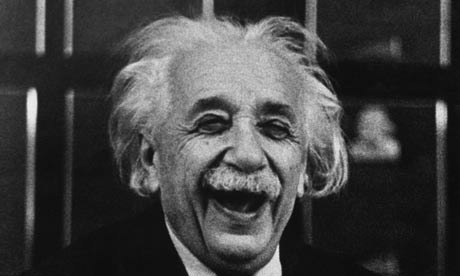Carl Sagan, the astronomer, Pulitzer Prize-winning author, and legendary popularizer of science, gave this interview in the mid-1990s during the making of NOVA's program "Time Travel." True to form, he discusses arcane aspects of the field—from how you define time to what it might look like inside a wormhole—with flair and a refreshing dash of humor.

Here Sagan stands near a model of the Voyager 2 spacecraft in January, 1986, soon after the release of his novel
Contact, which toyed with the notion of time travel.
Enlarge Photo credit: AP Photo/Lennox McLendon
The Nature of Time
NOVA: Let's start with the crux of the matter: What, for you, is time?
Carl Sagan: Ever since St. Augustine, people have wrestled with this, and there are all sorts of things it isn't. It isn't a flow of something, because what does it flow past? We use time to measure flow. How could we use time to measure time? We are stuck in it, each of us time travels into the future, one year, every year. None of us to any significant precision does otherwise. If we could travel close to the speed of light, then we could travel further into the future in a given amount of time. It is one of those concepts that is profoundly resistant to a simple definition.
"It might be that you can build a time machine to go into the future, but not into the past."
Do you think that backwards time travel will ever be possible?
Such questions are purely a matter of evidence, and if the evidence is inconsistent or insufficient, then we withhold judgment until there is better evidence. Right now we're in one of those classic, wonderfully evocative moments in science when we don't know, when there are those on both sides of the debate, and when what is at stake is very mystifying and very profound.
If we could travel into the past, it's mind-boggling what would be possible. For one thing, history would become an experimental science, which it certainly isn't today. The possible insights into our own past and nature and origins would be dazzling. For another, we would be facing the deep paradoxes of interfering with the scheme of causality that has led to our own time and ourselves. I have no idea whether it's possible, but it's certainly worth exploring.
Would you like it to be possible?
I have mixed feelings. The explorer and experimentalist in me would very much like it to be possible. But the idea that going into the past could wipe me out so that I would have never lived is somewhat disquieting.
On that note, can you describe the "grandfather paradox?"
The grandfather paradox is a very simple, science-fiction-based apparent inconsistency at the very heart of the idea of time travel into the past. It's very simply that you travel into the past and murder your own grandfather before he sires your mother or your father, and where does that then leave you? Do you instantly pop out of existence because you were never made? Or are you in a new causality scheme in which, since you are there you are there, and the events in the future leading to your adult life are now very different? The heart of the paradox is the apparent existence of you, the murderer of your own grandfather, when the very act of you murdering your own grandfather eliminates the possibility of you ever coming into existence.
Among the claimed solutions are that you can't murder your grandfather. You shoot him, but at the critical moment he bends over to tie his shoelace, or the gun jams, or somehow nature contrives to prevent the act that interrupts the causality scheme leading to your own existence.
Do you find it easy to believe the world might work that way—that is, self-consistently—or do you think it's more likely that that there are parallel universes?
It's still somewhat of a heretical ideal to suggest that every interference with an event in the past leads to a fork, a branch in causality. You have two equally valid universes: one, the one that we all know and love, and the other, which is brought about by the act of time travel. I know the idea of the universe having to work out a self-consistent causality is appealing to a great many physicists, but I don't find the argument for it so compelling. I think inconsistencies might very well be consistent with the universe.
"Maybe backward time travel is possible, but only up to the moment that time travel is invented."
As a physicist, what do you make of Stephen Hawking's chronological protection conjecture [which holds that the laws of physics disallow time machines]?
There have been some toy experiments in which, at just the moment that the time machine is actuated, the universe conspires to blow it up, which has led Hawking and others to conclude that nature will contrive it so that time travel never in fact occurs. But no one actually knows that this is the case, and it cannot be known until we have a full theory of quantum gravity, which we do not seem to be on the verge of yet.
One of Hawking's arguments in the conjecture is that we are not awash in thousands of time travelers from the future, and therefore time travel is impossible. This argument I find very dubious, and it reminds me very much of the argument that there cannot be intelligences elsewhere in space, because otherwise the Earth would be awash in aliens. I can think half a dozen ways in which we could not be awash in time travelers, and still time travel is possible.
Such as?
First of all, it might be that you can build a time machine to go into the future, but not into the past, and we don't know about it because we haven't yet invented that time machine. Secondly, it might be that time travel into the past is possible, but they haven't gotten to our time yet, they're very far in the future and the further back in time you go, the more expensive it is. Thirdly, maybe backward time travel is possible, but only up to the moment that time travel is invented. We haven't invented it yet, so they can't come to us. They can come to as far back as whatever it would be, say A.D. 2300, but not further back in time.
Then there's the possibility that they're here alright, but we don't see them. They have perfect invisibility cloaks or something. If they have such highly developed technology, then why not? Then there's the possibility that they're here and we do see them, but we call them something else—UFOs or ghosts or hobgoblins or fairies or something like that. Finally, there's the possibility that time travel is perfectly possible, but it requires a great advance in our technology, and human civilization will destroy itself before time travelers invent it.
I'm sure there are other possibilities as well, but if you just think of that range of possibilities, I don't think the fact that we're not obviously being visited by time travelers shows that time travel is impossible.
"Time travel into the indefinite future is consistent with the laws of nature."
How is the speed of light connected to time travel?
A profound consequence of Einstein's special theory of relativity is that no material object can travel as fast as light. It is forbidden. There is a commandment: Thou shalt not travel at the speed of light, and there's nothing we can do to travel that fast.
The reason this is connected with time travel is because another consequence of special relativity is that time, as measured by the speeding space traveler, slows down compared to time as measured by a friend left home on Earth. This is sometimes described as the "twin paradox": two identical twins, one of whom goes off on a voyage close to the speed of light, and the other one stays home. When the space-traveling twin returns home, he or she has aged only a little, while the twin who has remained at home has aged at the regular pace. So we have two identical twins who may be decades apart in age. Or maybe the traveling twin returns in the far future, if you go close enough to the speed of light, and everybody he knows, everybody he ever heard of has died, and it's a very different civilization.
It's an intriguing idea, and it underscores the fact that time travel into the indefinite future is consistent with the laws of nature. It's only travel backwards in time that is the source of the debate and the tingling sensations that physicists and science-fiction readers delight in.

Sagan's 1985 novel sparked not only a Hollywood film but also a slew of scientific papers speculating on the possibility of time travel.
Enlarge
A marvellous possibility
In your novel Contact, your main character Eleanor Arroway travels through a wormhole. Can you describe a wormhole?
Let's imagine that we live in a two-dimensional space. We wish to go from spot A to spot B. But A and B are so far apart that at the speed of light it would take much longer than a generational time or two to get there as measured back on world A. Instead, you have a kind of tunnel that goes through an otherwise inaccessible third dimension and connects A and B. You can go much faster through the tunnel, and so you get from A to B without covering the intervening space, which is somewhat mind-boggling but consistent with the laws of nature. And [the theoretical physicist] Kip Thorne found that if we imagine an indefinitely advanced technical civilization, such a wormhole is consistent with the laws of physics.
It's very different from saying that we ourselves could construct such a wormhole. One of the basic ideas of how to do it is that there are fantastically minute wormholes that are forming and decaying all the time at the quantum level, and the idea is to grab one of those and keep it permanently open. Our high-energy particle accelerators don't have enough energy to even detect the phenomenon at that scale, much less do anything like holding a wormhole open. But it did seem in principle possible, so I reconfigured the book so that Eleanor Arroway successfully makes it through the center of the galaxy via a wormhole.
"This innocent inquiry in the context of writing a science-fiction novel has sparked a whole field of physics."
What do you think it would be like to travel through a wormhole?
Nobody really knows, but what Thorne has taught me is that say, for example, you were going through a wormhole from point A to point B. Suppose point B was in orbit around some bright star. The moment you were in the wormhole, near your point of origin A, you would see that star. And it would be very bright; it wouldn't be a tiny point in the distance. On the other hand, if you look sideways, you would not see out of the wormhole, you would be in that fourth physical dimension. What the walls of the wormhole would be is deeply mysterious. And the possibility was also raised that if you looked backwards in the wormhole you would see the very place on world A that you had left. And that would be true even as you emerged out of the wormhole near the star B. You would see in space a kind of black sphere, in which would be an image of the place you had left on Earth, just floating in the blackness of space. Very Alice in Wonderland.
Your inquiries about space travel for Contact sparked a whole new direction in research on time travel. How does that make you feel?
I find it marvellous, I mean literally marvellous, full of marvel, that this innocent inquiry in the context of writing a science-fiction novel has sparked a whole field of physics and dozens of scientific papers by some of the best physicists in the world. I'm so pleased to have played this catalytic role not just in fast spaceflight but in the idea of time travel.
How do you feel being responsible for bringing time travel perhaps a step closer?
I don't know that I've brought time travel a step closer. If anyone has it's Kip Thorne. But maybe the joint effort of all those involved in this debate has at least increased the respectability of serious consideration of the possibility of time travel. As a youngster who was fascinated by the possibility of time travel in the science-fiction novels of H.G. Wells, Robert Heinlein, and others, to be in any way involved in the possible actualization of time travel—well, it just brings goose bumps. Of course we're not really at that stage; we don't know that time travel is even possible, and if it is, we certainly haven't developed the time machine. But it's a stunning fact that we have now reached a stage in our understanding of nature where this is even a bare possibility.
This feature originally appeared on the site for the NOVA program
Time Travel.




































